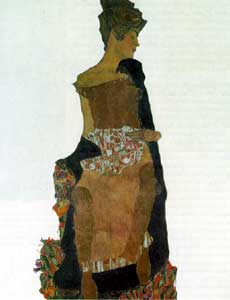By By Anna Piazza
The Neue Galerie has gathered provocative artist Egon Schiele’s finest works into a beautiful showcase displaying his talent in capturing emotion and beauty in all his figures. The gallery has collected his work from his art school years, where he initially discovered his style, as well as later developed works that were created up until his death. What makes his work so interesting and beautiful is his choice of subjects, complimented by his amazing ability to render the human body.
The gallery showcased many of his gorgeous figure drawings, which greatly overshadowed the few landscapes that were added. Although his landscapes showed a great understanding of Cubism, they were no match for the grace of his unique figures. Schiele captures the honesty and emotion on his subjects’ faces.
One interesting and touching subject he focused on early in his career was his younger sister Gerti. A large painting of her is found in the first room of the gallery simply entitled Gerti Schiele (1909). It is a beautiful representation of the young woman. Her expression seems to be of complete bliss and the S-curve of her figure is captured perfectly. Interestingly, the patterns on her dress are very reminiscent of Klimt, who was a huge influence on the artist.
When his sister grew up, Schiele’s focus turned to new faces. Most of his figures were very young women and prostitutes, usually posing nude or partially dressed, giving seductive looks to the viewer. One of his faithful models was Valerie Neuzil, known as Wally, a love of his who is featured in many of his drawings.
Their positions are very provocative, but one would hesitate to call them vulgar. He is not exploiting the person, but simply showing the beauty in their actions.
Many of these drawings are based solely on line, which is usually enough to give a sufficient amount of information. Line defines the depth of foreheads, cheekbones, knuckles, and knees. Vibrant colors are only sometimes used for tones, other times to highlight specific items, such as purple stockings or makeup on faces.
Another major aspect of his work are his self portraits, many of which were created after being accused of kidnapping and abusing Neuzil. While being held in prison, he would draw himself with different faces, trying to capture various emotional states. He never tried to make himself more handsome than he was, if anything, he made himself seem very eerie. The accusation insulted him personally and it comes through in his tortured faces. Nonetheless, he was able to keep a smug face in one self-portrait painted in 1910.
In it, Schiele shows his unique way of laying paint, looking as if it was scratched onto the paper. His movement of the brush gives his coat the volume it needs, but that is where he ends his work with paint. The rest of the figure is left to the tone of the paper.
This impressive collection of Schiele’s work will be on display through Feb. 20. It is definitely a showcase not to miss due to its passion, beauty and grace, which shines through his controversial and provocative subject matter.


Most of the figures Egon Schiele painted were very young girls and prostitutes. (Image courtesy artcopy-munich.com)
